2006 年 6 月 17 日英语四级真题及答案
试卷一
密封条由考生亲自启封
注意事项
一、将自己的校名、姓名、学校代号、准考证号写在答题纸和试卷二上。将本试卷代号划
在答题纸上。
二、试卷一、答题纸和试卷二均不得带出考场。考试结束,监考人员收卷后考生才可离开。
三、仔细读懂题目的说明。
四、在 90 分钟内做完试卷一上的 Part I 至 Part III 和试卷二上的 Part IV 90 分钟后,
监考人员收取答题纸和试卷一,然后考生再做试卷二上的作文题。作文题答题时间为 30 分钟。
全部考试时间为 120 分钟,不得拖延时间。
五、多项选择题的答案一定要划在答题纸上,凡是写在试卷上的答案一律无效。试卷二上
的题目答案直接写在试卷二上。
六、多项选择题每题只能选一个答案;如多选,则该题无分。选定答案后,用 HB 浓度以上
的铅笔在相应字母的中部划一条横线。正确的方法是:[A] [B] [C] [D]。
使用其它符号答题者不给分。划线要有一定粗度,浓度要盖过字母底色。
七、如果要改动答案,必须先用橡皮擦净原来选定的答案,然后再按上面的规定重新答题。
八、在考试过程中要注意对自己的答案保密,若被他人抄袭,一经发现,后果自负。
全国大学英语四、六级考试委员会
Part I Listening Comprehension (20 minutes)
Section A
Directions: Inthissection,youwillhear10shortconversations.Attheendofeach
conversation, a question will be asked about what war said. Both the
conversationandthequestionwillbespokenonlyonce:Aftereachquestion
therewillbeapause.Duringthepause,youmaxireadthefourchoicesmarked
A), B), C) and D), and decide which is, the best answer. Then mark the
corresponding letter on the Answer Sheet with a single line through the
center.
Example:
You will hear:
You will read:
A) At the office.
B) In the waiting room.
C) At the airport.
D) In a restaurant.
�
From the conversation we know that the two were talking about some work they had
to finish in the evening. This conversation is most likely to have taken place at the
office. Therefore, A) “At the office” is the best answer. You should choose [A] on
the Answer Sheet and mark it with a single line through the centre.
Sample Answer [A] [B] [C] [D]
1.
A) They went a long way to attend the party.
B) They didn’t think much of the food and drinks.
C) They knew none of the other guests at the party.
D) They enjoyed the party better than the other guests.
2.
A) To the bookstore.
B) To the dentist’s.
C) To the market.
D) To the post office.
3.
A) Dr. Andrews has been promoted for his thoroughness.
B) She disagrees with Dr. Andrews on many occasions.
C) Dr. Andrews used to keep his patients waiting.
D) She dislikes Dr. Andrews as much as the new physician.
4.
A) Tom is usually talkative.
B) Tom has a very bad temper.
C) Tom has dozens of things to attend to.
D) Tom is disliked by his colleagues.
5.
A) To pickup the woman from the library.
B) To make a copy of the schedule for his friend.
C) To find out more about the topic for the seminar.
D) To get the seminar schedule for the woman.
6.
A) The woman has to get the textbooks in other ways.
B) The woman has sold her used textbooks to the bookstore.
C) The man is going to buy his textbooks from a bookstore.
D) The man doesn’t want to sell his textbooks to the woman.
7.
A) Attend a conference.
B) Give a speech.
C) Meet his lawyer.
�
D) Make a business trip.
8.
A) Jessie always says what she thinks.
B) Jessie seems to have a lot on her mind.
C) Jessie is wrong to find fault with her boss.
D) Jessie should know the marketing director better.
9.
A) Helen is talkative.
B) Helen is active.
C) Helen is sociable.
D) Helen is quiet.
10. A) Jimmy will regret marrying a Frenchwoman.
B) Jimmy is rich enough to buy a big house.
C) Jimmy is not serious in making decisions.
D) Jimmy’s words are often not reliable.
Section B
Directions: Inthissection,youwillhear3shortpassages.Attheendofeachpassage,
you will hear some questions. Both the passage and the questions will be
spokenonlyonce.Afteryouhearaquestion,youmustchoosethebestanswer
fromthefourchoicesmarkedA),B),C)andD).Thenmarkthecorresponding
letter on the Answer Sheet with a single line through the centre.
Questions 11 to 13 are based on the passage you have just heard.
Passage One
11. A) It can be used by farmers to protect large buildings.
B) It was brought to the northern USA by Asian farmers.
C) It has done more harm than good in the southern USA.
D) It was introduced into the USA to kill harmful weeds.
12. A) People will have to rely on kudzu for a living.
B) They will soon be overgrown with kudzu.
C) They will become too hard to plough.
D) People will find it hard to protect the soil.
13. A) The farmers there have brought it under control.
B) The factories there have found a good use for it.
�
C) The climate there is unfavorable to its growth.
D) The soil there is not so suitable for the plant.
Questions 14 to 17 are based on the passage you have just heard.
Passage Two
14. A) A business corporation.
B) The universe as a whole.
C) A society of legal professionals.
D) An association of teachers and scholars.
15. A) Its largest expansion took place during that period.
B) Its role in society went through a dramatic change.
C) Small universities combined to form bigger ones.
D) Provincial colleges were taken over by larger universities.
16. A) Private donations.
B) Government funding.
C) Grants from corporations.
D) Fees paid by students.
Questions 18 to 20 are based on the passage you have just heard.
Passage Three
17. A) He was wounded in the Spanish civil war.
B) He was interested in the study of wild animals.
C) He started the organization Heifer International.
D) He sold his cows to many countries in the world.
18. A) To help starving families to become self-supporting.
B) To make plans for the development of poor communities.
C) To teach people how to use new skills to raise animals.
D) To distribute food to the poor around the world.
19. A) They should help other families the way they have been helped.
B) They should offer all baby animals to their poor neighbors.
C) They should submit a report of their needs and goals.
D) They should provide food for the local communities.
�
20. A) It has improved animal breeding skills all over the world.
B) It has helped relieve hunger in some developing countries.
C) It has promoted international exchange of farming technology.
D) It has bridged the gap between the rich and the poor in America.
Part II Reading Comprehension (35 minutes)
Passage one
Directions: There are 4 passages in this part, Each passage is followed by some
questionsatunfinishedstatements.Foreachofthemtherearefourchoices
markedA),B),C)andD).Youshoulddecideonthebestchoiceandmarkthe
corresponding letter on the Answer Sheet with a single line through the
center.
Questions 21 to 25 are based on the following passage.
Interest in pursuing international careers has soared in recent years, enhanced
by chronic (长久的) personnel shortages that are causing companies to search beyond
their home borders for talent.
Professionals seek career experience outside of their home countries for a variety
of reasons. They may feel the need to recharge their batteries with a new challenge.
They may want a position with more responsibility that encourages creativity and
initiative. Or they may wish to expose their children to another culture, and the
opportunity to learn a second language.
When applying for a job, one usually has to submit a resume or curriculum vitae
(CV). The two terms generally mean the same thing: a one-or two-page document describing
one’s educational qualifications and professional experience. However, guidelines for
preparing a resume are constantly changing. The best advice is to find out what is
appropriate regarding the corporate (公司) culture, the country culture, and the
culture of the person making the hiring decision. The challenge will be to embrace two
or more cultures in one document. The following list is a good place to start.
● “Educational requirements differ from country to country. In almost every case
of ‘cross-border’ job hunting, just stating the title of your degree will not bean
adequate description. Provide the reader with details about your studies and any related
experience.”
●
Pay
to
the
resume
attention
or
reverse-chronological order. Chronological order means listing your ‘oldest’ work
experience first. Reverse-chronological order means listing your current or most recent
experience first. Most countries have preferences about which format is most acceptable.
If
reverse-chronological format.”
use-chronological
guidelines,
preference
you
find
no
is
for
the
the
general
specific
format
you
● If you are submitting your resume in English, find out if the recipient (收
件人) uses British English or American English because there are variations between
�
the two versions. For example, university education is often referred to as ‘tertiary
education’ in the United Kingdom, but this term is almost never used in the United
States. A reader who is unfamiliar with these variations may assume that your resume
contains errors.
21. Companies are hiring more foreign employees because ________.
A) they find foreign employees are usually more talented
B) they need original ideas from employees hired overseas
C) they want to expand their business beyond home borders
D) they have difficulty finding qualified personnel at home
22. The author believes that an individual who applies to work overseas ________.
A) is usually creative and full of initiative
B) aims to improve his foreign language skills
C) is dissatisfied with his own life at home
D) seeks either his own or his children’s development
23. When it comes to resume writing, it is best to ________.
A) take cultural factors into consideration
B) learn about the company’s hiring process
C) follow appropriate guidelines for job hunting
D) know the employer’s personal likes and dislikes
24. When writing about qualifications, applicants are advised to ________.
A) stress their academic potential to impress the decision maker
B) give the title of the university degree they have earned at home
C) provide a detailed description of their study and work experiences
D) highlight their keen interest in pursuing a ‘cross-border’ career
25. According to the author’s last piece of advice, the applicants should be aware
of ________.
A) the different educational systems in the US and the UK
B) the differences between the varieties of English
C) the recipient’s preference with regard to the format
D) the distinctive features of American and British cultures
Questions 26 to 30 are based on the following passage.
Passage Two
�
Educating girls quite possibly yields a higher rate of return than any other
investment available in the developing world. Women’s education may be unusual
territory for economists, but enhancing women’s contribution to development is
actually as much an economic as a social issue. And economics, with its emphasis on
incentives (激励), provides guideposts that point to an explanation for why so many
girls are deprived of an education.
Parents in low-income countries fail to invest in their daughters because they do
not expect them to make an economic contribution to the family: girls grow up only to
marry into somebody else’s family and bear children. Girls are thus seen as less
valuable than boys and art kept at home to do housework while their brothers are sent
to school-the prophecy (预言) becomes self-fulfilling, trapping women in a vicious
circle (恶性循环) of neglect.
An educated mother, on the other hand, has greater earning abilities outside the
home and faces an entirely different set of choices. She is likely to have fewer but
healthier children and can insist on the development of all her children, ensuring that
her daughters are given a fair chance. The education of her daughters then makes it
much more likely that the next generation of girls, as well as of boys, will be educated
and healthy. The vicious circle is thus transformed into a virtuous circle.
Few will dispute that educating women has great social benefits. But it has enormous
economic advantages as well. Most obviously, there is the direct effect of education
on the wages of female workers. Wages rise by 10 to 20 per cent for each additional
year of schooling. Such big returns are impressive by the standard of other available
investments, but they are just the beginning. Educating women also has a significant
impact on health practices, including family planning.
26. The author argues that educating girls in developing countries is ________.
A) troublesome
B) labor-saving
C) rewarding
D) expensive
27. By saying “... the prophecy becomes self-fulfilling...” (Lines 45, Para. 2). the
author means that ________.
A) girls will turn out to be less valuable than boys
B) girls will be capable of realizing their own dreams
C) girls will eventually find their goals in life beyond reach
D) girls will be increasingly discontented with their life at home
28. The author believes that a vicious circle can turn into a virtuous circle when
________.
A) women care more about education
�
B) girls can gain equal access to education
C) a family has fewer but healthier children
D) parents can afford their daughters’ education
29. What does the author say about women’s education?
A) It deserves greater attention than other social issues.
B) It is now given top priority in many developing countries.
C) It will yield greater returns than other known investments.
D) It has aroused the interest of a growing number of economists.
30. The passage mainly discusses ________.
A) unequal treatment of boys and girls in developing countries
B) the potential earning power of well-educated women
C) the major contributions of educated women to society
D) the economic and social benefits of educating women
Passage Three
Questions 31 to 35 are based on the following passage.
Speeding off in a stolen car, the thief thinks he has got a great catch. But he
is in for an unwelcome surprise. The car is fitted with a remote immobiliser (锁止
器), and a radio signal from a control centre miles away will ensure that once the thief
switches the engine off, he will not be able to start it again.
The idea goes like this. A control box fitted to the car contains a mini-cellphone,
a micro-processor and memory, and a GPS(全球定位系统) satellite positioning receiver.
If the car is stolen, a coded cellphone signal will tell the control centre to block
the vehicle’s engine management system and prevent the engine being restarted.
In the UK, a set of technical fixes is already making life harder for car thieves.
‘The pattern of vehicle crime has changed,’ says Martyn Randall, a security expert.
He says it would only take him a few minutes to teach a person how to steal a car, using
a bare minimum of tools. But only if the car is more than 10 years old.
Modern cars are far tougher to steal, as their engine management computer won’t
allow them to start unless they receive a unique ID code beamed out by the ignition
(点火 ) key. In the UK, technologies like this have helped achieve a 31% drop in
vehicle-related crime since 1997.
But determined criminals are still managing to find other ways to steal cars, often
by getting bold of the owner’s keys. And key theft is responsible for 40% of the thefts
of vehicles fitted with a tracking system.
If the car travels 100 metres without the driver confirming their ID, the system
will send a signal to an operations centre that it has been stolen. The hundred metres
minimum avoids false alarms due to inaccuracies in the GPS signal.
�
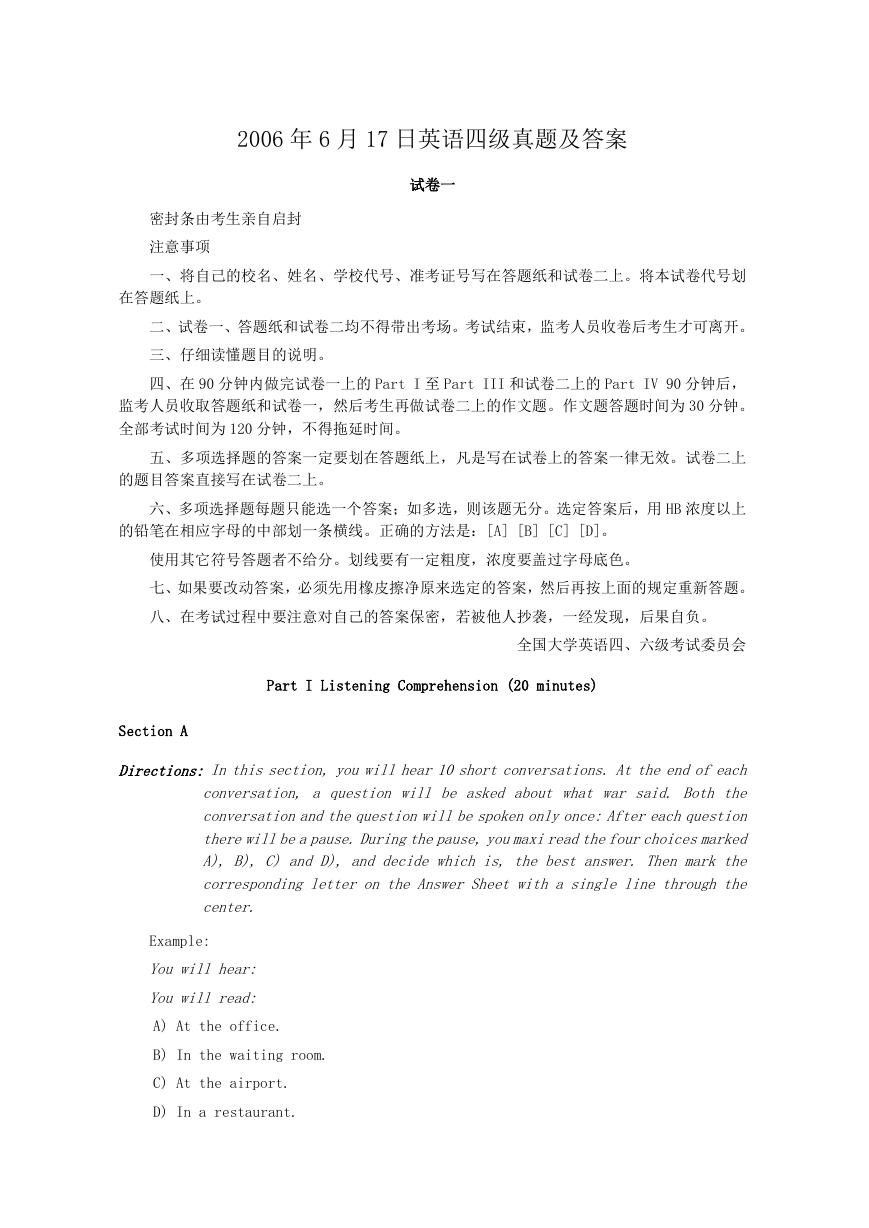
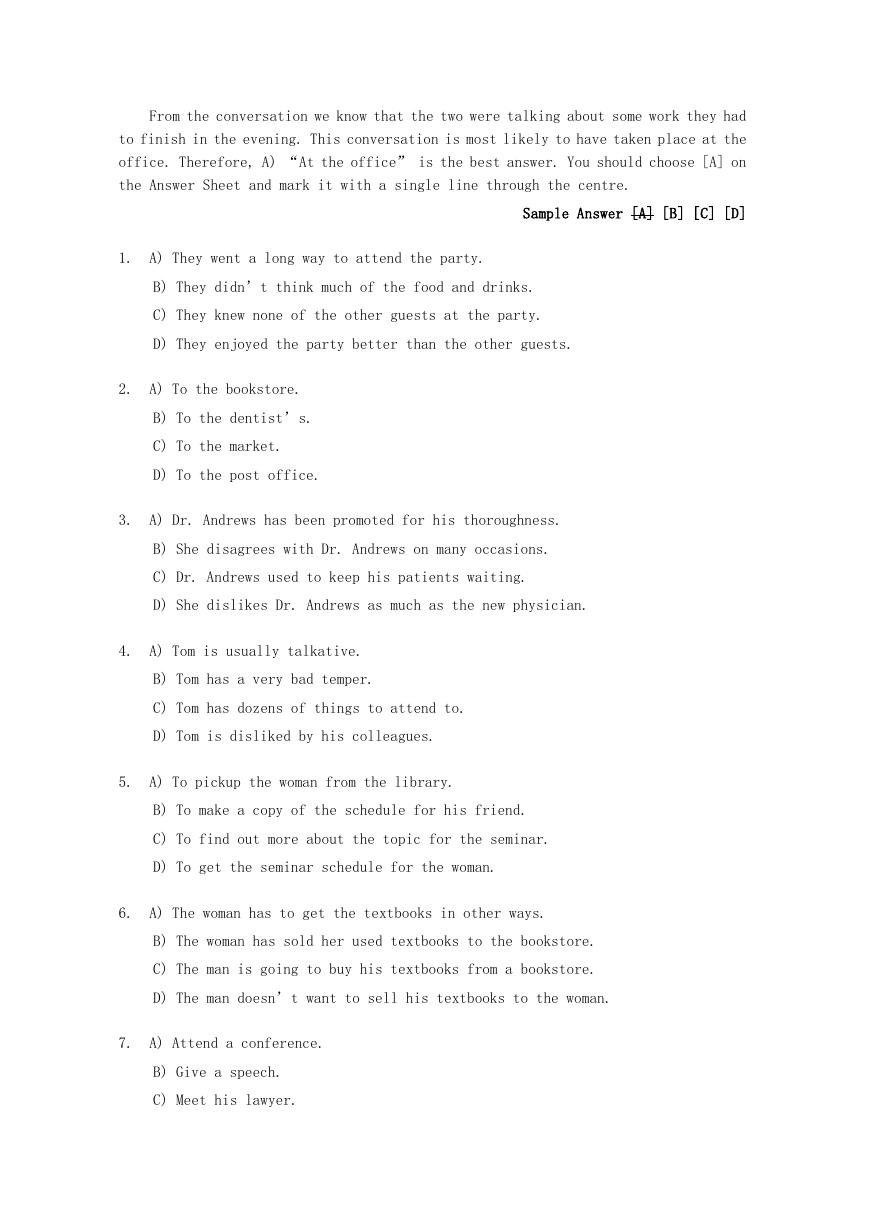
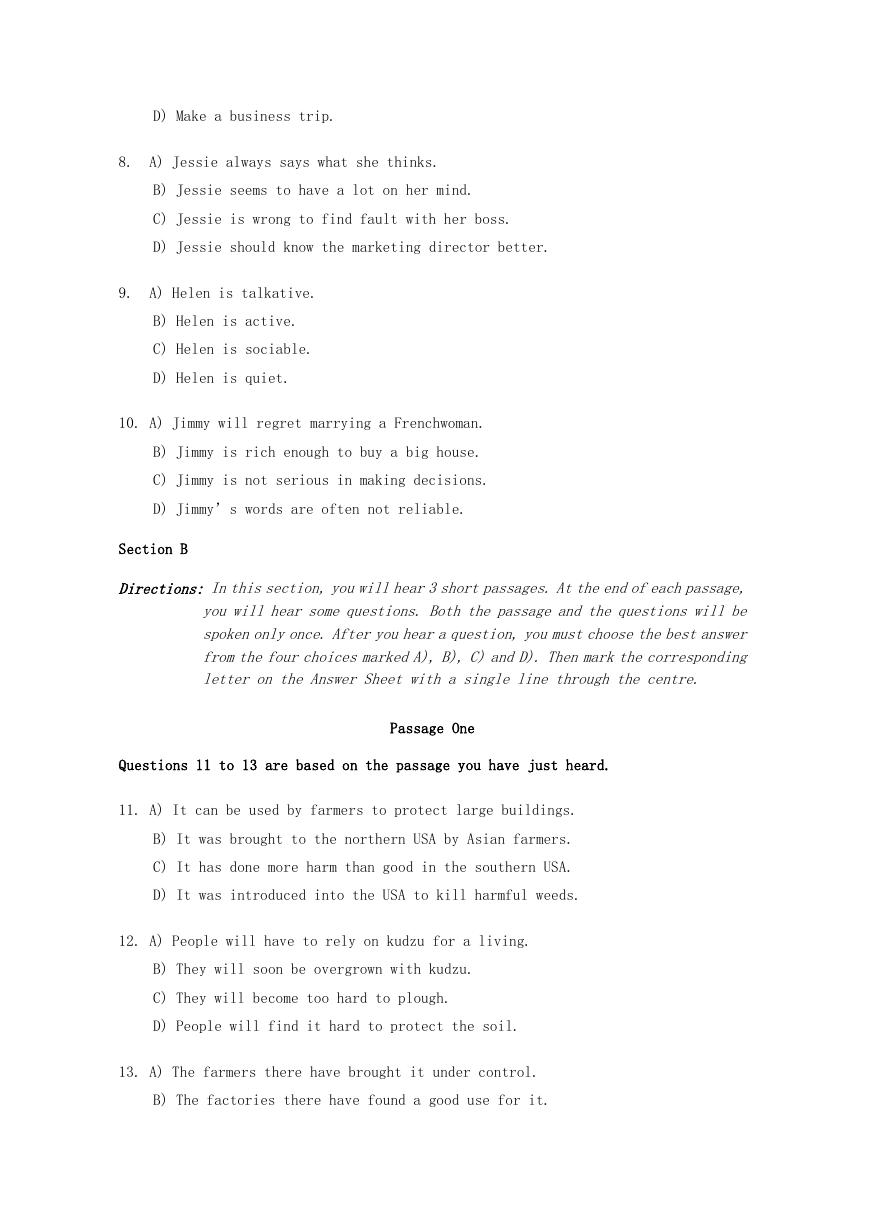
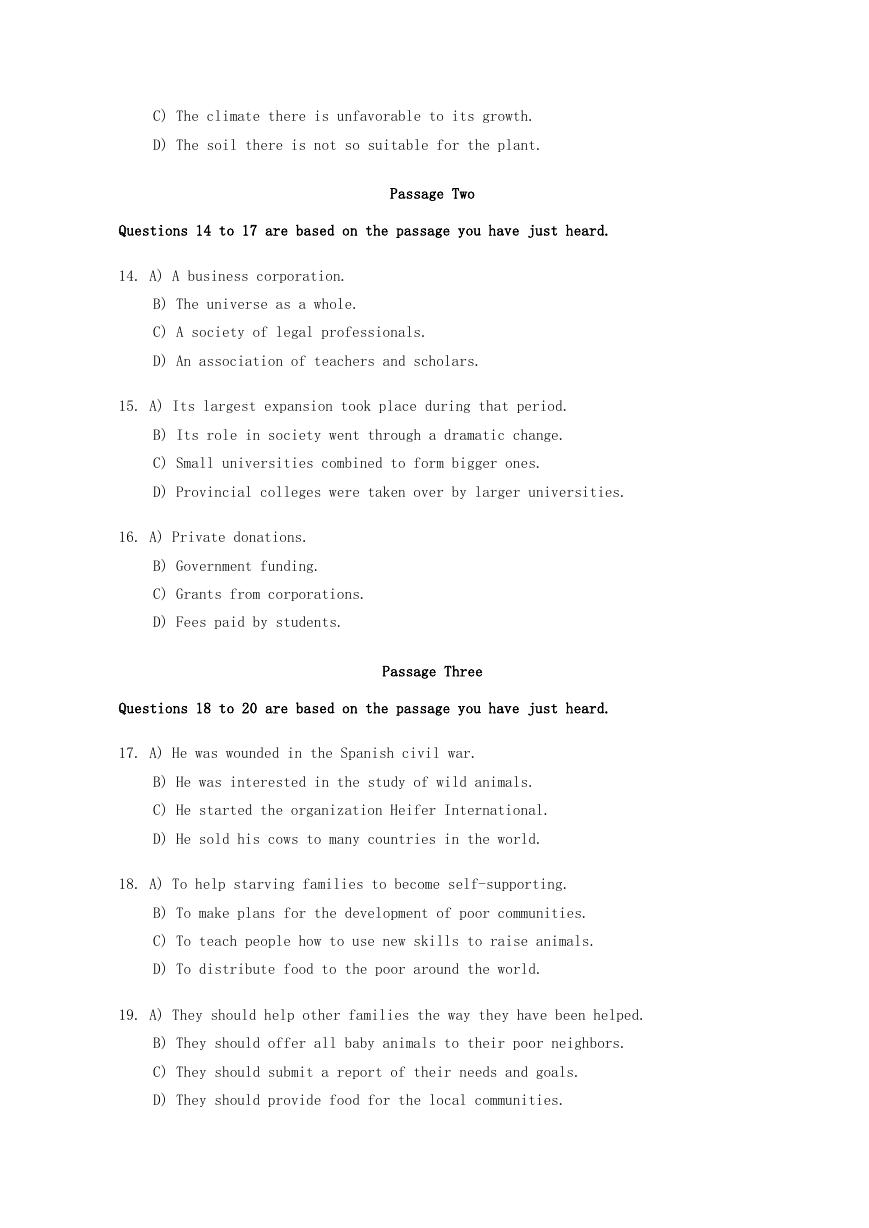
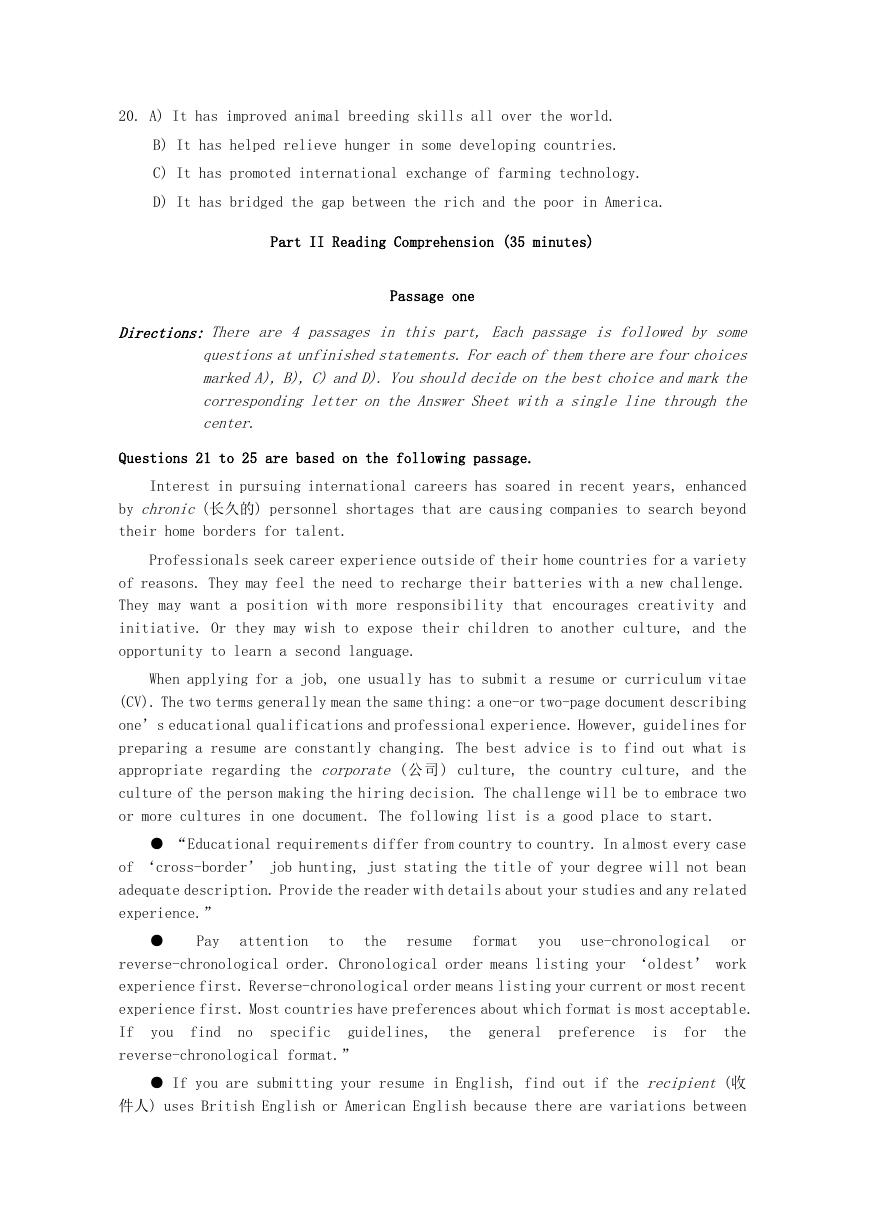
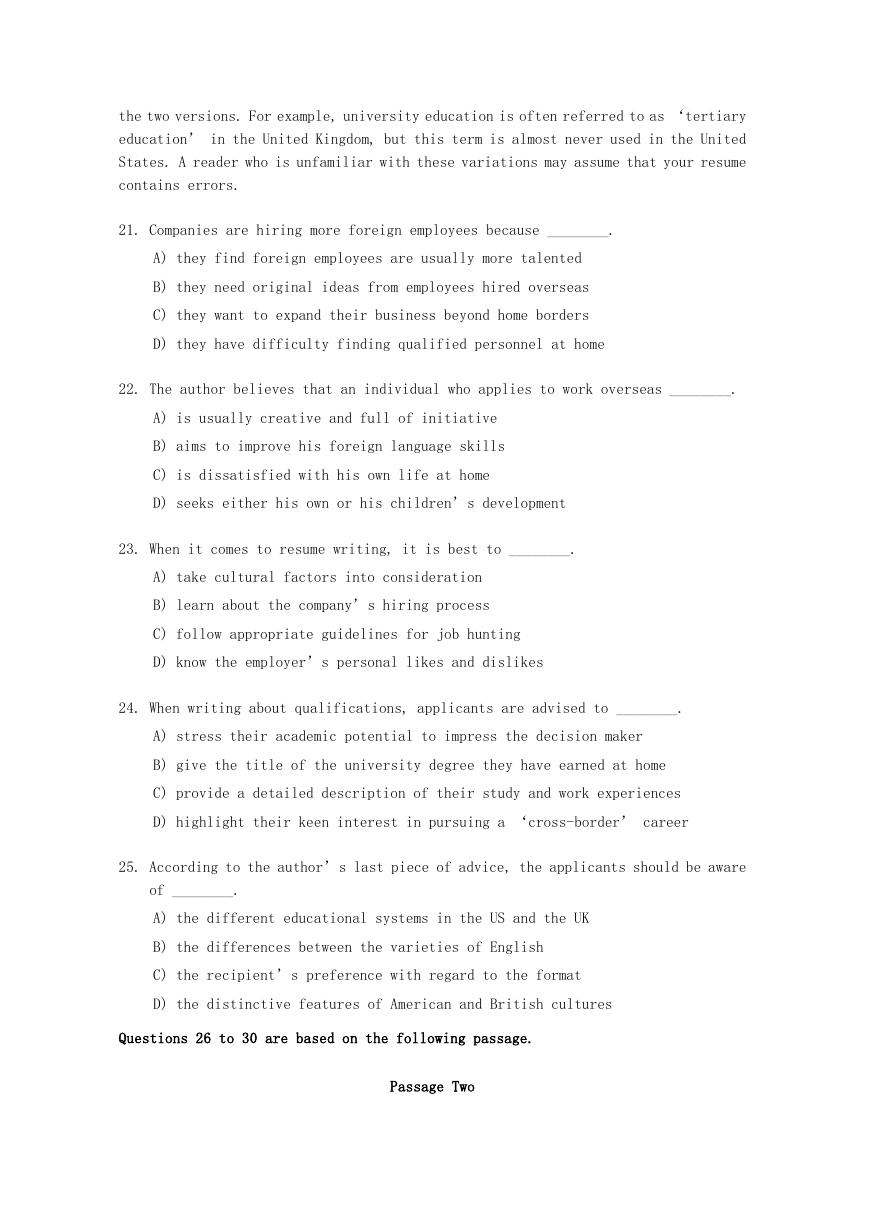
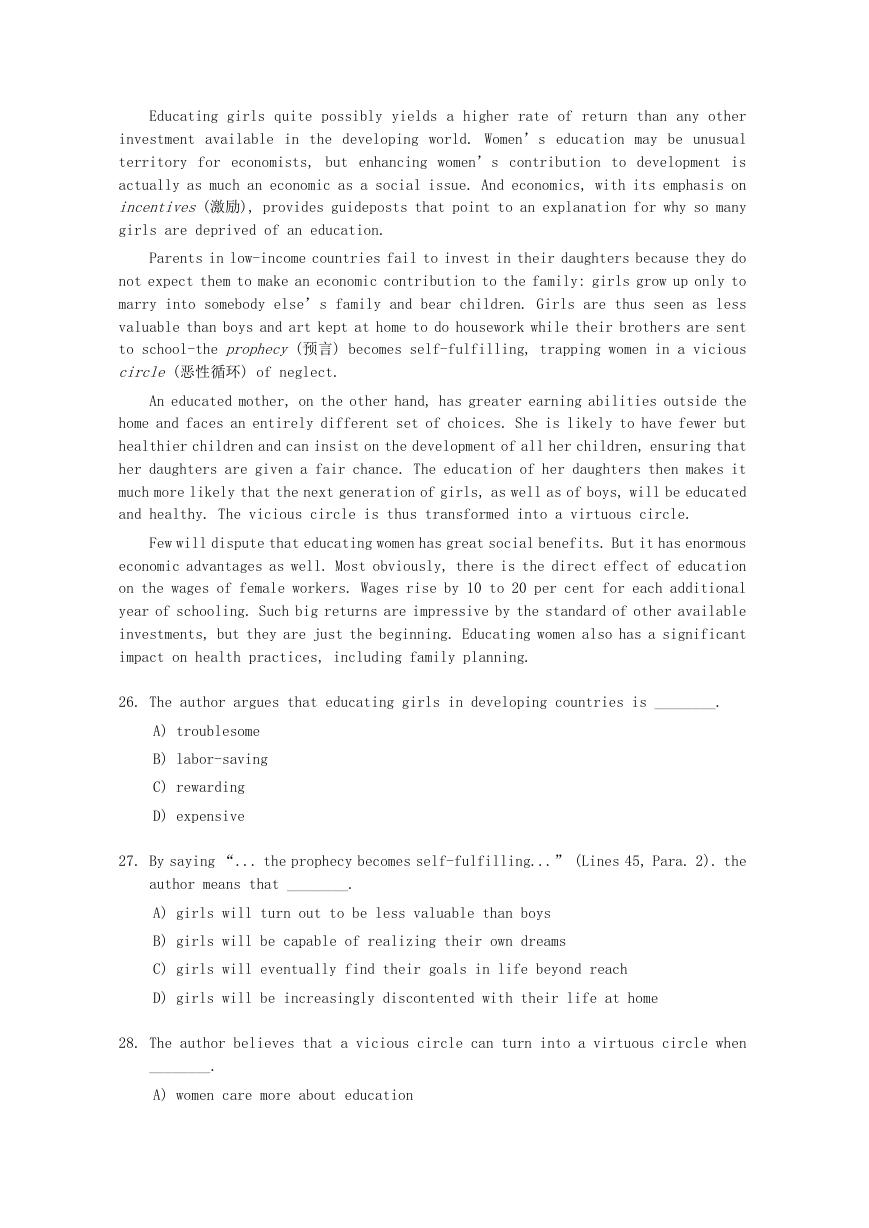
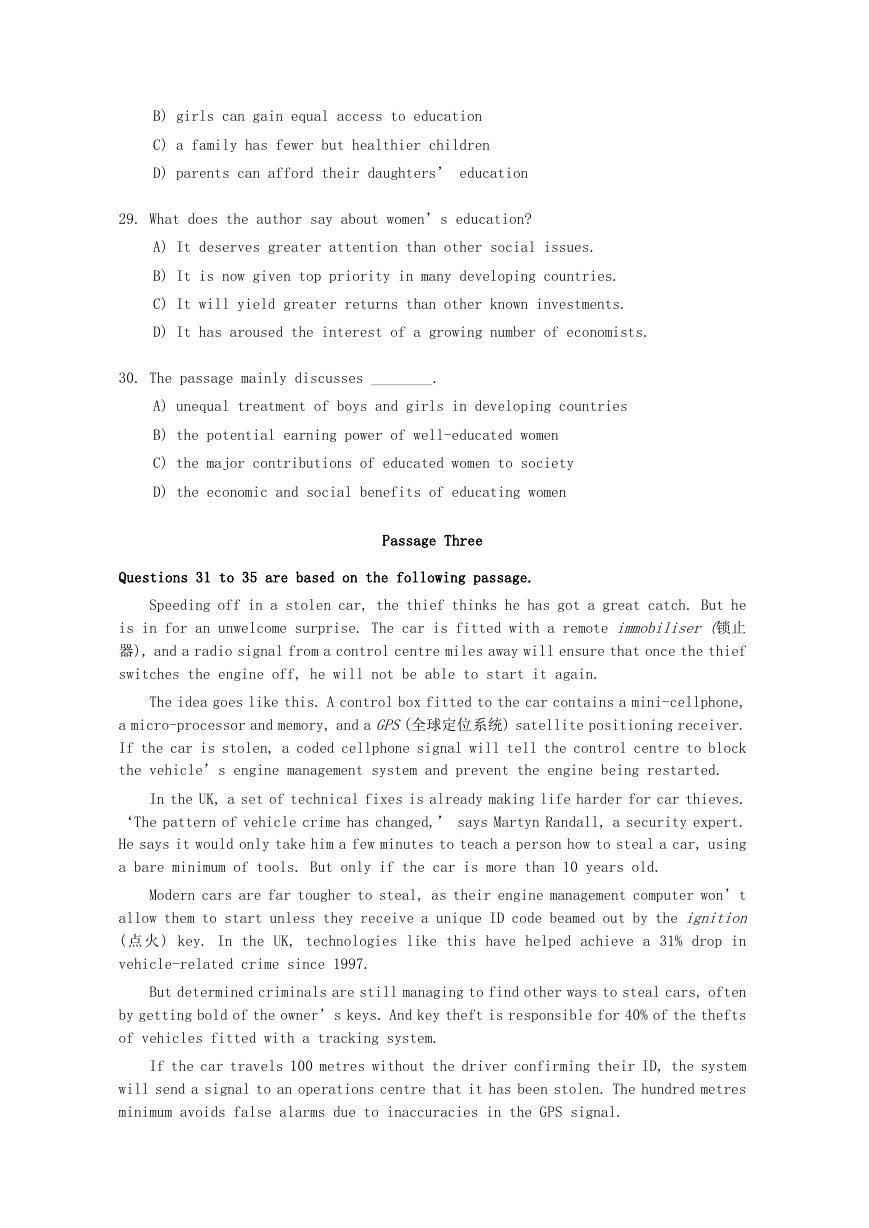








 2023年江西萍乡中考道德与法治真题及答案.doc
2023年江西萍乡中考道德与法治真题及答案.doc 2012年重庆南川中考生物真题及答案.doc
2012年重庆南川中考生物真题及答案.doc 2013年江西师范大学地理学综合及文艺理论基础考研真题.doc
2013年江西师范大学地理学综合及文艺理论基础考研真题.doc 2020年四川甘孜小升初语文真题及答案I卷.doc
2020年四川甘孜小升初语文真题及答案I卷.doc 2020年注册岩土工程师专业基础考试真题及答案.doc
2020年注册岩土工程师专业基础考试真题及答案.doc 2023-2024学年福建省厦门市九年级上学期数学月考试题及答案.doc
2023-2024学年福建省厦门市九年级上学期数学月考试题及答案.doc 2021-2022学年辽宁省沈阳市大东区九年级上学期语文期末试题及答案.doc
2021-2022学年辽宁省沈阳市大东区九年级上学期语文期末试题及答案.doc 2022-2023学年北京东城区初三第一学期物理期末试卷及答案.doc
2022-2023学年北京东城区初三第一学期物理期末试卷及答案.doc 2018上半年江西教师资格初中地理学科知识与教学能力真题及答案.doc
2018上半年江西教师资格初中地理学科知识与教学能力真题及答案.doc 2012年河北国家公务员申论考试真题及答案-省级.doc
2012年河北国家公务员申论考试真题及答案-省级.doc 2020-2021学年江苏省扬州市江都区邵樊片九年级上学期数学第一次质量检测试题及答案.doc
2020-2021学年江苏省扬州市江都区邵樊片九年级上学期数学第一次质量检测试题及答案.doc 2022下半年黑龙江教师资格证中学综合素质真题及答案.doc
2022下半年黑龙江教师资格证中学综合素质真题及答案.doc